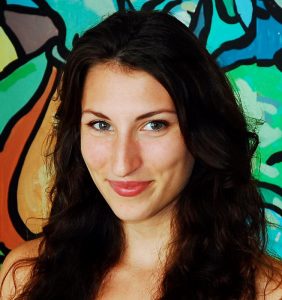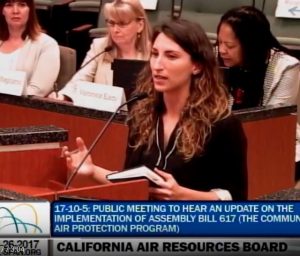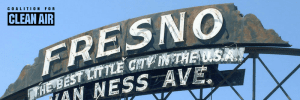By Rocky Rushing

Clean-air advocate Genevieve Gale gives no hint to what hides just beneath her pleasant smile and disposition when she talks about her work as policy associate for the Central Valley Air Quality Coalition (CVAQ) and the struggle for environmental justice.
But ask this 27-year old Fresno resident about what fuels her fight against the pollution that fouls the San Joaquin Valley’s air and anger near the boiling point surfaces.
“When I look down from the [Sierra]
mountains and see the pollution Valley residents live in and have to breathe every day, I get so angry,” she recently told Coalition for Clean Air. “It is hard for me to not start screaming from the top of my lungs; but I know that is not going to help.”
Gale, a Detroit native who came to Fresno three years ago from Nashville, Tenn. where she graduated from Vanderbilt University, has managed to keep her cool while making clean-air strides for the San Joaquin Valley and impressing long-time environmentalists.
“In a short period of time, Genevieve has made a big difference in the struggle to clean up the air in the San Joaquin Valley,” observed Bill Magavern, CCA’s Policy Director. “She researches the facts, organizes community members and persistently advocates the clean-air cause to policymakers.”
Gale also received kudos recently from members of the California Air Resources Board (CARB) for her work on the community nomination process under AB 617 (2017). AB 617 requires CARB to select some of California’s most polluted communities for prioritized efforts to improve air quality through enhanced monitoring, clean technologies and strengthened safeguards and enforcement.

The list compiled by Gale and her colleagues was submitted to CARB for consideration and later endorsed by the San Joaquin Valley Air Pollution Control District.
No other agriculture region in the world is more productive than the San Joaquin Valley where over 250 crops are grown. It also has some of the dirtiest air in the nation. Large dairies, diesel trucks zooming down Interstate 5 and Highway 99, agricultural rigs and oil and gas facilities spew out air-borne toxins that, when combined, create poisonous particulate matter (PM) and ozone pollution.
On August 7, Gale will help lead a busload of community activists to the state Capitol for the 15th Annual CVAQ Action Day, where they will urge legislators to support bills that will help clean up the Valley’s air and improve the health of millions who live there.
Gale started with the CVAQ as a volunteer in 2015 and became its policy associate in early 2016.
What influences do you credit for your embracing environmental justice as a vocation? Or would you consider it a calling?
“I think it was moving to Fresno and experiencing air pollution first hand. Generally it came as anger that other people’s pollution was allowed to impact my own heath and other people around me. Perhaps it was coming from (Nashville) that wasn’t polluted and having that taken away from me.”
What drew you to the CVAQ?
“It is the only non-profit in the 8-county region of the Valley that is dedicated solely to air quality.”
The report on AB 617 community-selection process has received great praise. Would you consider the report as a high-water mark for CVAQ or for yourself?
“Not really. I think it is really great that the (San Joaquin Valley) air district recommended the communities we selected. That’s a high water mark for the Valley.”
How significant is AB 617 in improving air quality in underserved communities?
“It has the potential to address the communities that have been left behind in the state’s implementation plans. However, the bill itself lacks strong targets and enforcement so only time will tell.”
The vast majority of communities nominated in your report are rural. Talk a little about the plight of rural communities when it comes to the environmental justice
struggle.
“I don’t feel I’m the best person to speak to this but the San Joaquin Valley as a region has often been left out of state decision-making, and the rural communities are left out even more so because they are not population centers. These communities lack access to safe and affordable drinking water. They are often on the fence-line to major industries that produce a lot of toxic contaminants like large farms and large dairies… They also lack basic infrastructure like sidewalks, grocery stores, and buses that connect them to the population centers. And they are geographically isolated from the people who make decisions for them.”
The San Joaquin Valley has some of the nation’s worst air quality, failing to meet federal health standards for both ozone (smog) and PM pollution. What particular challenges do you face in fighting for clean air in the Valley?
“We have an air district that generally believes the Valley can reach clean air. However, the District does not share the same sense of urgency that we advocates and community residents feel. That’s the main issue.”
Describe your work as an environmental justice advocate in front of the SJ air district board? Do you feel you’re out gunned by industry representatives before the board?
“The board meetings are held on Thursday mornings, which is not a time accessible to the general public, so paid advocates paint skewed optics of the San Joaquin Valley. The majority of residents want clean air now, but don’t have an opportunity to share that (desire) with the Board.”
What inspires you?
“It’s the people that you meet that are inspiring and worth fighting for, especially the young people. I heard a high schooler from southwest Fresno say recently, ‘I don’t want to die early;’ or the older residents who have to leave, to move a way, or they will die. How do we allow that to happen?”
Tell me about your association with Coalition for Clean Air.
“CCA has funded some of my work in the Valley regarding the PM2.5 plan and has always provided a statewide perspective and policy expertise to CVAQ which we always appreciate. That’s the beauty of CVAQ – it works because of the participation of its coalition members and the strengths they bring.”
What do you see for your future?
“Right now I am working with young people from the region to introduce them to the world of environmental justice and advocacy and help them build their resumes in the world of green work so if and when I leave the valley there will be more young people to step up to bat … I am also hoping to go to law school and provide legal expertise to the environmental justice community.”
How to you deal with your anger?
”I strategize. I brainstorm. I sit with a marker and a dry erase board. I also run Young Fresnans for the Environment . They are awesome. They are the future of the Valley.”
[share title=”Share This Post”]








